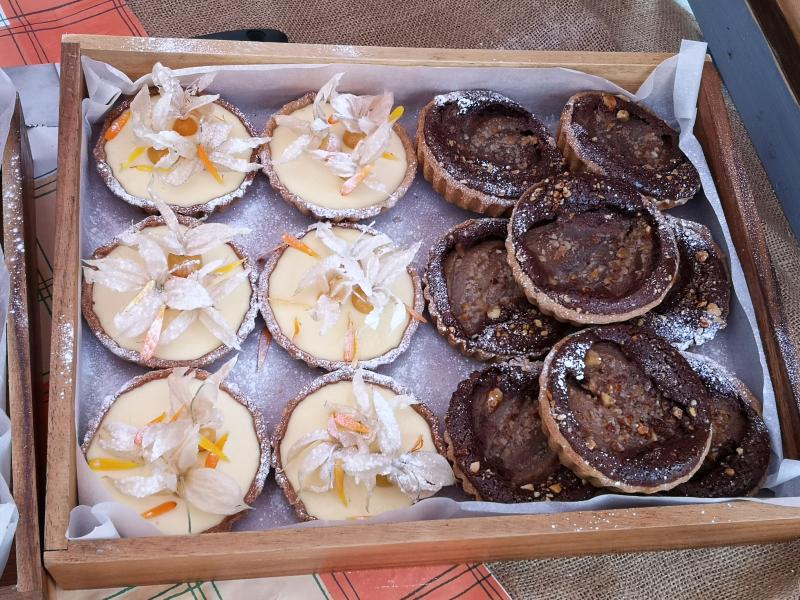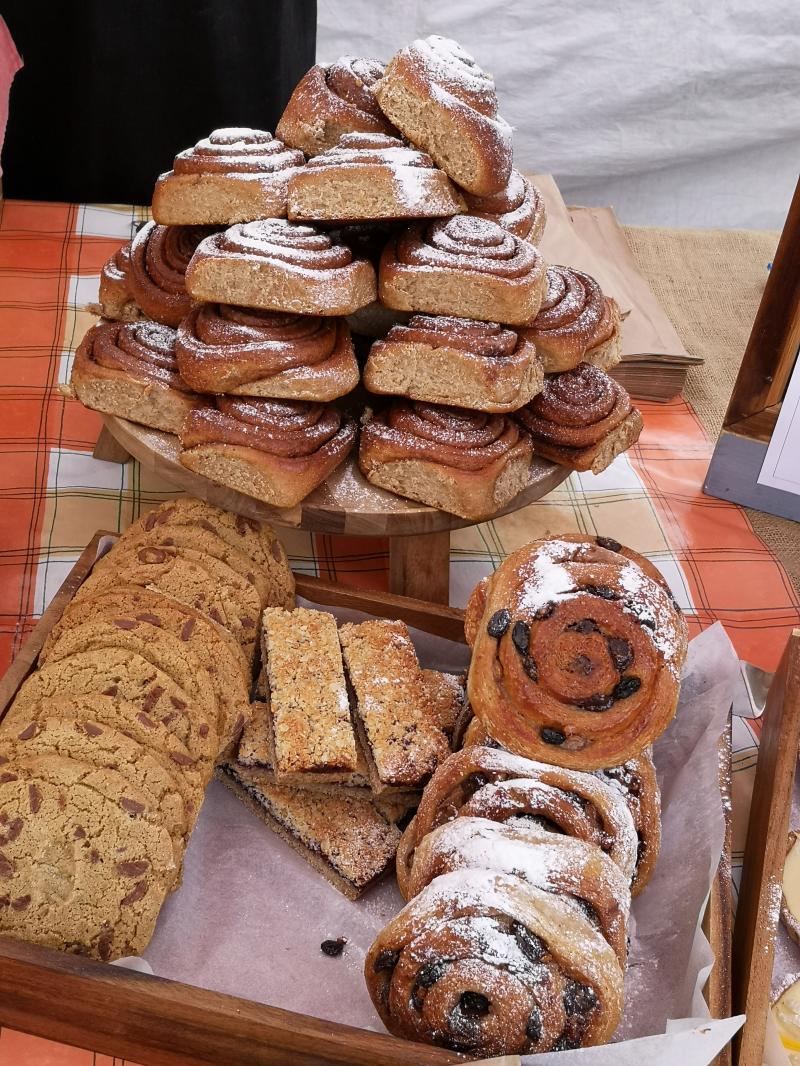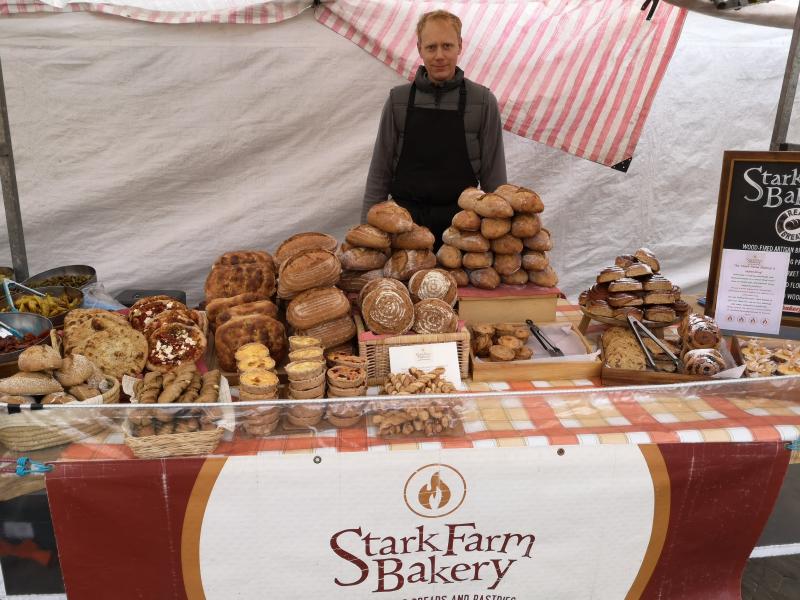search
date/time
 | Lancashire Times A Voice of the Free Press |

Andrew Palmer
Group Editor
8:37 AM 13th November 2019
business
The Business Interview: Dan Barrow Artisan Baker

The Stark Bakery woodfired oven. Photographer Victoria Harley
Hardly noticeable from the roadside is the sign that I have been looking for, Stark Farm, and I am here to meet Dan Barrow, an artisan baker supremo, who not only has a passion and enthusiasm for everything to do with sourdough breads and other pastry delights, but understands and employs sustainable methods to support his entrepreneurial business.
.jpg)
Dan with the Chard Photographer Victoria Harley
“Have you had lunch?” he asks. To which I reply “no”. “Well come in then and let’s put the kettle on.” Dan’s partner Matilda, has just made lunch for the children and I join them in the family kitchen to tuck into some delicious artisan breads, homegrown tomatoes, dried apple and pears from the orchard, the perfect accompaniment to the cheese.
As I enjoy the breads, feeling rather greedy for accepting an offer for another slice, Dan gives me a potted history. Stark Farm is a ten acre smallholding, with greenhouse, veg patch, orchard and woodland areas.
Dan’s story starts the same as for many of us. Having graduated from Liverpool University, with a history and philosophy degree, he didn’t quite know what to do next. So with Matilda, whom he had met at Liverpool, they took to travelling ending up in Japan to teach English.
“It had always been an idea to do something overseas; after Japan we ended working and travelling in New Zealand and Australia.
“At some point the idea of being a chef came into my mind probably as we faced the prospect of coming back to the UK. Matilda’s parents, Caroline and Greg, started talking to us about joining them here.
.jpg)
Piel & oven Photographer Victoria Harley
“It was an interesting time then. When I started it the beginning of the change in food attitudes, that we are seeing now. I thought I would just do a year with Sophie, the owner of Teahee but ended up there 4 years later.”
“I was always happy with anything to do with pastry. I had an initial idea to start a café but that all changed when I read a book about woodfired ovens.
That’s when the penny dropped and Dan, with the right entrepreneurial mindset, a desire to follow a more sustainable way of life, the knowledge and experience of baking, decided on a lifestyle change. It also coincided with Caroline and Greg moving south for a short while and so the enterprise began.

The Artisan Baker
“I started to plan the bakery and read up about woodfired ovens. There was one book in particular, The Bread Builders by Dan Wing, a passionate advocate about woodfired ovens, that inspired me. He had co-authored it with Alan Scott, who in the woodfired oven world, was the guru.
“His plans had gone around the world and he was considered a big reference point. At the end of each chapter there was a little piece about different bakeries. By the final chapter, I thought we have the wood, so why not give it a go.”
So, the first thing Dan set out to do was buy plans for a woodfired oven, which helpfully, Alan Scott’s daughter, were selling.
“Once they arrived, I got a friend, the husband of Sophie at Teahee, a builder by trade, to help and between us we built the oven. Well he did I made coffee!
“The woodfired oven house was the first thing as I thought I could prep and bake in our kitchen. However, that was just not going to work. So, we quickly followed up with development plans and the kitchen prep area was built next door to the oven.”
It was always Dan’s plan to produce a full range of bakery products. He chose a smaller oven designed for bread, explaining “a number of ovens are bigger with a lot more mass giving an opportunity to bake a much greater volume of bread, but for me it would have been foolish not to include all the things I knew how do already.
“With a smaller oven I produce fewer loaves but as the temperature drops it allows me more options to use the different temperature ranges. This is one of the nice things which has held true; the big range of products I have on the market stalls is through having the smaller oven. A big bread oven stays too hot for longer.”
I’m interested to find out how it all works I know it has something to do with thermal mass but that’s as far as I get. There is quite an artistry to the process as Dan demonstrates.
The wood burns and heats the oven using, and for me it brings back memory of physics lessons at school. The walls and roof gain heat through radiation, then it is conduction from the surface of the fire bricks to the food, plus convection from the hot, steamy swirling interior air.
“Because mine is a smaller oven, it has less thermal mass. That means, I have to bake on a higher temperature. So, basically, I bake on a temperature between 500- and 600-degrees F, (260° - 315°C), which, if you said that to most bakers, they would comment it is crazy, far too hot. But the smaller oven doesn’t store the same amount of heat, which means it needs a slightly higher temperature to build up.
“I have an order of baking: the flat breads go in first, followed by the twists and focaccias. Basically, I go from small thinner breads, gradually getting to bigger loaves, the bloomers next, then the smaller followed by the larger sourdoughs. When you get to the point where the large sourdough breads come out, it’s now that the oven has lost the bread temperature.

Savoury tarts
The whole process is fascinating and Dan explains that although he has timers it’s an experience thing too; “You kind of know especially with the breads when they are ready, largely to do with colour.
“As the bloomers bake at a higher temperature, they particularly need extra steam- this is to keep a moist environment to prevent the crust setting too quickly.
“These are the things to watch and to tweak. If the crust sets too quickly and the bread is still expanding that produces cracks, which is why bread makers score loaves, although it is mainly decorative the bread expands along the lines you have cut it on.

Sweet tarts
It seems the oven presents a challenge. Each one is different and I can tell from the way Dan talks about it with such enthusiasm that he has also developed a unique relationship and understanding how the oven responds. Once it How it is fired up it dictates how he uses it and that structures Dan’s week.
He uses the oven to cook for the family on Sunday, then Monday is slow cooking pie fillings and fruit drying such as apples and roasting tomatoes to make passata.
Chatting with Dan, it is apparent that sustainability is really important issue for him, and looking round his prep area there are lots of ingredients and he is proud to explain the provenance.
“For the ingredients, as much as is possible is locally grown. The flour is the key thing. Everything is made with a Yorkshire organic flour, milled up in Kirby Moorside by Yorkshire Organic Millers. As a supplement, I also use Shipton Mill Organic Flour, to get more strength in the breads and a local grown rye flour. There is a vast array of flours but as a small producer I just need a few. One of the things is the flour is not as refined plus there is a lot more wholemeal in it.

A selection of buns including the Business Editor's favourite cinnamon bun
“One of the areas I’m always trying to improve on is waste. I am currently working with a local butter producer. Like nearly everyone I buy 250g blocks which produces waste so I hope to cut down on that. “
This artisan baker is also an innovator trying new recipes and ideas but he knows what his market desires.
“Breads, I keep fairly stable. I gradually realised people want basic simple breads.
“The ideas for the sweet tarts are driven by what is in season in his garden. Now for example we have autumn fruits which will drive my thinking.
This year we have had a bumper season for raspberries and also a good crop of pears, which I have bottled using the oven. That will keep me going through the winter. I can also poach them to make a sauce.
Changes for next season will begin with forced rhubarb, before our own batch is ready.

As the stark bakery’s popularity grows there will be a need to expand and Dan has aspirations to take on a member of staff, “there is way too much for one person and with all bakers the hours are long.”
“If I can get to that point and find someone to work alongside me and take on more, I can then work out ways to expand.
“The easy option would be to take on another market, such as Knaresborough, but that does need someone to do the baking plus someone to do sell. It’s about thinking what the other options are and to think slightly outside the box.
“I can think about development and trying new possibilities like littles cakes or biscotti at Christmas
“The ultimate thing is to link the buildings together, develop a new section for the bakery bread section and run courses. All part of my five-year plan.“
“We initially moved in just to look after the farm thinking it was short term and the excitement took over and we gradually took on more.
Just before I depart, replete from a fantastic lunch. I am interested to hear Dan’s views on why there has been an explosion in artisan foods. He believes it is due to the way we think about sustainability, farming methods, obesity and ways to improve food production.
“It would be nice if the artisan way was not niche. It has to be embedded as part of food production. Farmer to producer to customer. That way, we all think more about how things are produced, the energy input. For example, the use of heat and energy that is produced from the oven saves having to use more energy.”
.jpg)
The Stark Bakery woodfired oven
“There are health issues connected with production of food manufactured by industry, and this, coupled with the way ingredients are sprayed, the use of certain type of chemicals used on wheat, enzymes etc., has led to much discussion. Obviously, the wheats we grow are hard to digest. It is, however, a complicated catalogue of things.
“The sourdough process is slower which makes it more digestible. Fermenting things comes back to strong arguments in favour of the process, as it enables the body to access the nutrients much better. This is how we ate for a long time for most of human history until about 100 years ago. So, it would make sense if our bodies geared up.”
.JPG)
Apple Blossom Photographer Victoria Harley
I can see why this is important as I look round the natural habitat of Stark Farm, the tree planting, the organic food all these issues are important and interrelate to the issues around food production.
Much food for thought and as I leave Dan preparing for his biggest individual seller, the savoury tarts, getting his prep in for the 100 breads that he will produce this week, 22 of which are large sourdoughs, I feel there is a real soul in everything that Dan produces, all created by the magic and mystery of the woodfired oven.